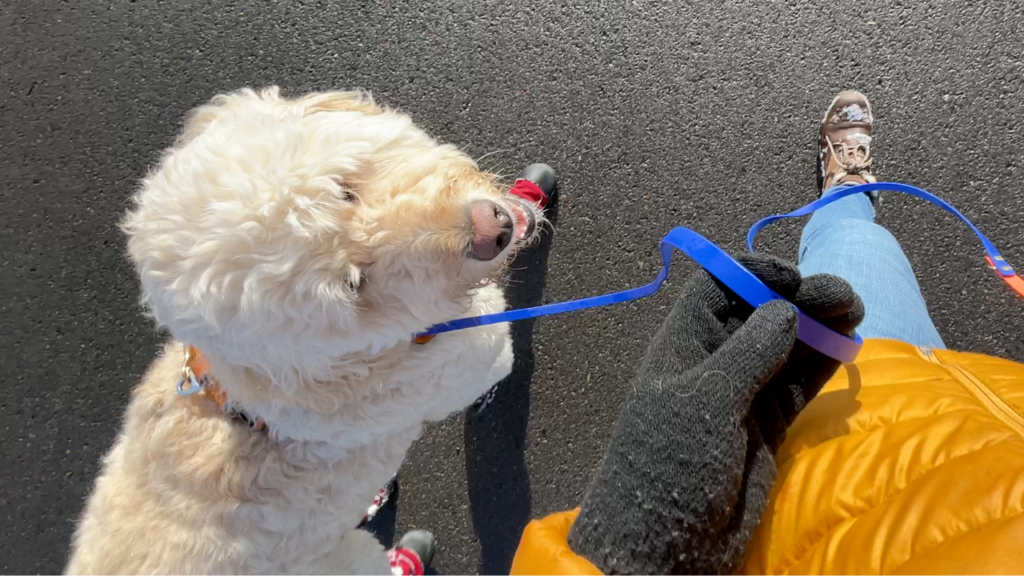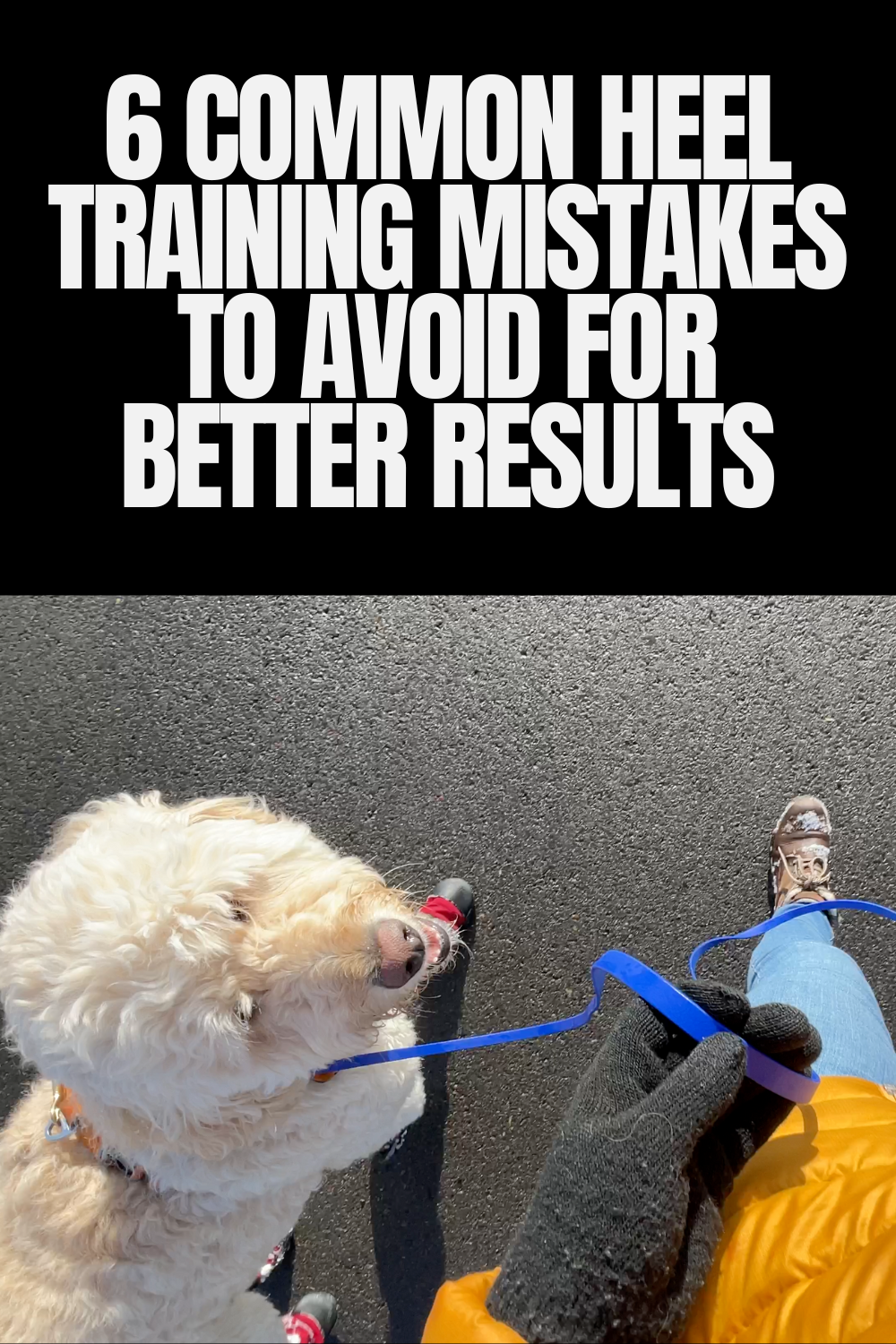In my years as a dog trainer, I’ve taught many dogs and dog guardians how to get a dog to walk nicely in a heel using force-free training. However, I’ve also noticed 6 heel training mistakes that people commonly make. In this blog I want to share a few tips for how to perfect heel training with your dog!
If you prefer video tutorials, watch this on Youtube:
Before we jump into the training mistakes, I want to define a few things & discuss why I even bother teaching a dog to heel.
I define the term heel as a dog walking right next to my side, at my pace, without stopping for sniff breaks. If you’re thinking that that sounds quite strict, I would agree with you. For that reason I instead walk dogs loose leash most of the time, which I define as them going anywhere that they want on the leash as long as there isn’t leash tension.
Dogs obviously enjoy loose leash walking more, but heel is a fantastic skill when you’re walking on busy sidewalks, when you want to walk quickly to get more exercise, or when you simply want to get to a specific location.
Heel is also a helpful skill to use at times if you’re working on leash reactivity, since your dog will be close by for rewarding or for management techniques like a U-turn.
Heel is a valuable skill to teach, but I have noticed six really common mistakes people make when training their dog to heel.
Even after many years of doing this, I myself am personally guilty of mistake number four and I have to actively remind myself not to do it. Today I’m going to discuss what those six heel training mistakes are and how to fix them!
Heel training mistake #1: Using too large of treats as a reward
When you’re training heel you want to use rewards that the dog can taste, but that are small enough they don’t even need to chew.
Why? For best results, I always like to keep any sort of leash training fully in motion.
If the treats are too large, the dog will likely want to stop to chew which can slow down progress. Using small treats also allows you to reward more frequently without giving too many calories or causing stomach upset. This helps keep the treats very high value and reinforcing for your dog!
Heel training mistake #2: Letting your dog choose to leave the heel position
I think of heel similar to the rules that I would set when I train stay: once I’ve given that cue I want the dog to maintain that request until they hear the release cue.
I previously created a step-by-step tutorial with Charlotte showing how I train heel and how I teach a release cue for her to transition to loose leash walking instead.
It’s important to remember that your dog should stay in that heel position until you release them from it. If the dog chooses to leave the heel position I simply turn the opposite direction, cue the dog to follow me, and then I reward them for doing so.
If you let the dog release themselves to go do something such as sniff, then they’ve self-rewarded for breaking that heel position and the skill will never be quite as solid as if you set specific rules. Again I am all for walking loose leash most of the time, but if I ask for a heel that’s the position that I want the dog to stay in until told otherwise!
Heel training mistake #3: Offering the reward too high so the dog needs to jump for it
With large dogs this is rarely a concern, but it is a mistake that I commonly see when people are trying to train smaller dogs to heel.
If you offer the reward too high, you’re accidentally reinforcing a jumping behavior that you likely don’t want. Doing so frequently can also encourage your dog or puppy to be more snappy and to take treats more harshly. If you’re leash training a puppy or a shorter dog, I highly encourage you to check out this one minute video. It’s both helpful and funny!
Heel training mistake #4: Rewarding across your body
This is the mistake that I still catch myself doing ALL the time because I prefer to have dogs walk on my left side but I’m very right-handed. However, rewarding across your body encourages the dog to cut in front of you since that’s the position that they’ve previously been rewarded in. This increases the chances of them being a tripping hazard.
Try to remind yourself yourself to reward your dog right at your side rather than in front of you!
Heel training mistake #5: Stopping to reward
I always encourage people to remember the goal of what they’re trying to teach. When you’re training heel, you want the dog to be in motion, at your pace, at your side.
If we stop to reward we’re not actually reinforcing the movement, we’re reinforcing the stop. As an extreme example of this if you always reward after stopping you can teach the dog to purposely stall on walks to get treats because that’s what they’ve learned gets reinforced. Dogs repeat what we reinforce, so we have to make sure that we are rewarding what we intend to! Practice marking and rewarding your dog for heeling while maintaining movement and you’ll be shocked at how much faster they learn to stay walking in a heel.
Heel training mistake #6: Increasing the difficulty too quickly
Imagine if you were trying to teach a child something…. Practicing the new skill in a quiet setting where the child can concentrate will lead to way more success than if you try to teach it at Disneyland.
For dogs, busy settings with lots of sounds, smells, and other dogs is basically like trying to teach them a new skill at Disneyland. It’s going to be very frustrating for both you and them, so don’t start training there! Instead, I encourage you to build a foundation of skills and a strong reinforcement history in a more calm setting and then slowly progress the difficulty.
Think about it like this: it’s up to us to teach our dog the alphabet before we get frustrated that they don’t know how to spell.
If you’ve been making these mistakes and you’ve noticed that they’re affecting your dog’s ability to heel, try not to stress about it. Dogs are always learning, so use today as an opportunity to teach a little bit better.
Happy training, I’ll see you in the next blog post!

Disclosure: Happy Hounds uses affiliate links. Purchasing with these links will not cost you any extra, but I get commissions for purchases made through these links. Affiliate links help me to continue to offer free resources & blog posts. I would love if you used them!


+ show Comments
- Hide Comments
add a comment